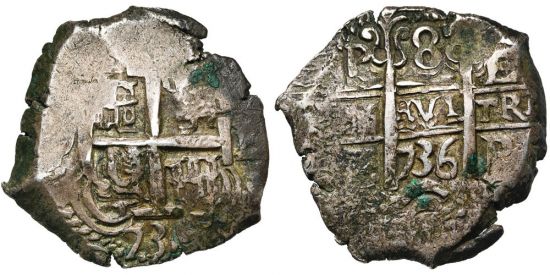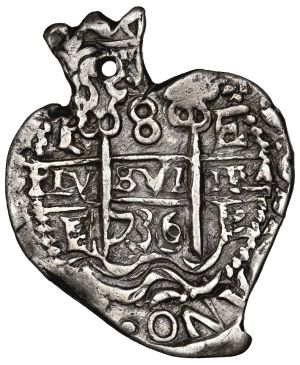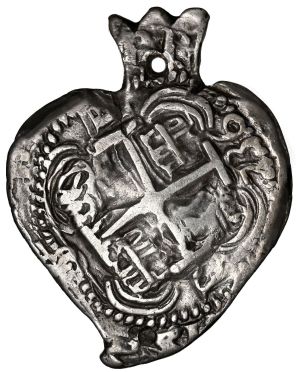Bolivia 1736-P E 8 reales
The Spanish colony of Upper Peru produced hammered cob coinage at the Potosi mint from 1573 to 1773, with a major debasement scandal and subsequent reform occurring in 1649-1652. The period 1767-1770 saw simultaneous issue of milled columnarios. The royal or presentation issues are very rare and highly sought after, while the regular strikes vary in price according to the visibility of the date, mint, and assayer initials. The first specimen was lot 1844 in Jean Elsen sale 147 (Brussels, June 2021), where it sold for €420 (about US$614 including buyer's fees). The catalog description[1] noted,
"BOLIVIE, Philippe V (1700-1746), AR 8 reales, 1736E, Potosi. D/ Croix potencée cantonnée de lions et de tours. R/ Les colonnes d'Hercule. Les deux dates lisibles. Très Beau. (Bolivia, Philip V, 1700-46, silver eight reales of 1736, Potosi mint. Obverse: cross potent cantonned with two lions and tow castles; reverse: the pillars of Hercules. Two legible dates, Very Fine.)"
The second specimen was lot 857 in Sedwick sale 34 (Winter Park, FL, November 2023), where it sold for $54,000. The catalog description[2] noted,
"Potosi, Bolivia, cob 8 reales Heart, 1736 E, unique, NGC AU details / rev damage, finest and only example in NGC census. As a type, the rarest and most highly sought pieces in Potosi cobs, even beyond the rare and special Royals, are the Hearts, intentionally shaped at the mint and struck with Royal dies, presumably to be worn or otherwise displayed in a religious setting, as the flaming Sacred Heart of Jesus Christ was (and is) an important symbol in the Catholic Church. With few exceptions, they were unique to the Potosi mint and struck in all denominations except the 1/4R, beginning in the late 1680s and issued sporadically until the 1750s. The most desirable Hearts are the 8 reales, of which only 42 examples exist across 17 dates. Once in a blue moon a new date shows up, which is the case here. While its shape and axis are a somewhat atypical (the rules being a bit flexible toward the end, this being the second-to-last date before a single-known 1737), the strike is quite bold and well centered, and the surfaces are smooth and even (the toning is lovely too). There does appear to be a contemporaneous clip on one of the "shoulders," and of course the stem at top has a customary hole, but these are minor distractions from what is a unique example within a beautiful type. (See lot 907 for a matching-date 4R Heart, also a new discovery.)"
Recorded mintage: unknown but a common date.
Specification: 27.07 g, 0.917 silver, 0.798 oz ASW, the first specimen 26,11 g, the second specimen 25.41 grams.
Catalog reference: Cayón-9394, S-P46; KM-31a, Cal. 1571.
- Cayón, Adolfo, Clemente Cayón and Juan Cayón, Las Monedas Españolas, del Tremis al Euro: del 411 a Nuestros Dias, 2 volumes, Madrid: Cayón-Jano S.L., 2005.
- Calicó, Xavier, Numismática Española: Catálogo General con Precios de Todas las Monedas Españolas Acuñadas desde Los Reyes Católicos Hasta Juan Carlos I, 1474 a 2001, Barcelona: Aureo & Calicó, 2008.
- Michael, Thomas, Standard Catalog of World Coins, 1701-1800, 7th ed., Iola, WI: Krause Publications, 2016.
- Menzel, Sewall, Cobs, Pieces of Eight and Treasure Coins, New York: The American Numismatic Society, 2004.
- Paoletti, Emilio, 8 Reales Cobs of Potosi, 2nd Ed., Buenos Aires, 2006.
- [1]Elsen, Philippe, et al., Vente Publique 147: Monnaies, Médailles et Décorations, Brussels: Jean Elsen et ses Fils S.A., 2021.
- [2]Sedwick, Daniel Frank, Augi Garcia, Cori Sedwick Downing and Connor Falk, Treasure Auction 34, World, U.S Coins and Paper Money, Winter Park, FL: Daniel Frank Sedwick LLC, 2023.
Link to:


